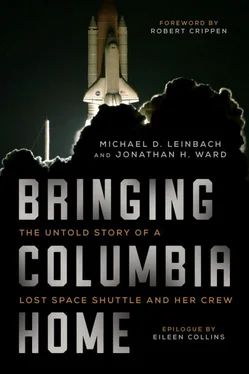On Pat Adkins’s last day in Hemphill before he returned to KSC, he walked around the downtown area and visited every shop. He tried to buy something in each shop as a small way to say “thank you” for the way everyone in town had taken such good care of him.
Search operations continued for a short time in the western end of the debris field, until the number of identifiable shuttle pieces being recovered dropped to less than one per grid. [20] NASA, Report CB-QMS-024 , 9.
At this point, the CAIB had already announced their conclusions as to the root cause of the accident. Additional material recovered was not likely to change those conclusions.
All ground search operations in Texas ended by April 30, and the remaining fire crews demobilized on May 1. The Nacogdoches site closed down on May 3, and Corsicana closed on May 4. The Longview staging area shuttered its operations on May 7. [21] USDA Forest Service, “Fire and Aviation Management Briefing Paper, Columbia Support, Interagency Support to Space Shuttle Columbia Recovery Effort,” USDA Forest Service, Washington, DC, May 2, 2003.
Limited search operations moved to Utah starting on May 2. Teams spent about eight days trying to find an object tracked by radar after falling off Columbia . They were unable to locate the object or any other debris from the shuttle in their search.
—
NASA’s Space Flight Awareness organization sponsored a huge dinner in Lufkin on April 29 to celebrate the end of recovery operations.
The event was held in Lufkin’s Civic Center, where the emergency operations center was established on the afternoon of the accident. Huge posters from KSC and the recovery sites hung on the walls. Tables and chairs were draped with gold covers. The scale of the event was impressive—a party only Texans can throw—feeling to Ed Mango like the celebration scene in the movie The Right Stuff .
Jan Amen reported, “Dinner was steak and chicken, green beans, rice, rolls, salad, pie, all prepared by the Diboll Country Club. Free drinks flowed freely.” [22] Jan Amen email, April 30, 2003.
Administrator O’Keefe hosted the event for NASA, and Scott Wells spoke on behalf of FEMA. County judges and civic leaders from every county in East Texas were on hand. Judge Jack Leath, Tom Maddox, Greg Cohrs, Roger and Belinda Gay, Marsha Cooper, and a host of other people represented Sabine County. Dignitaries from the various Native American Tribes and Nations attended. An astronaut sat at every table.
Dom Gorie opened the ceremony with a heartfelt invocation that brought tears to the eyes of nearly everyone present. The Expedition Six crew sent a live video message from the International Space Station. A video about the Columbia crew followed.
O’Keefe and Dave King presented plaques recognizing the nation’s appreciation for the contributions of the people at every table in the hall. The spouses of Columbia ’s crew spoke of their gratitude to the people of East Texas for bringing their loved ones home again. Eileen Collins closed the ceremony on behalf of the next shuttle crew scheduled to fly in space. [23] “Columbia Shuttle Recovery Appreciation Program” (Lufkin, TX: April 29, 2003), program agenda.
It was a fitting and emotional close to a tumultuous three months. The people of East Texas had provided the nation and the world with an enduring lesson in how to handle a crisis with dignity, compassion, and competence.
At the end of the evening, after Jan Amen dropped off her last load of astronauts and families at their hotels, she emailed to a friend, “I absolutely lost it. I squalled all the way back to Cudlipp like a big fat crybaby. I’m whooped!”
—
The largest land search-and-recovery operation in United States history had finally ended. This was the first incident under the overall auspices of the new Department of Homeland Security, and about 450 federal, state, and local agencies and volunteer organizations worked together in a textbook example of interagency cooperation and collaboration with local communities.
In the weeks between February 1 and May 10, 2003, nearly twenty-five thousand men and women searched 680,750 acres of land—in essence, walking every square foot of an area roughly the size of the state of Rhode Island. The US Forest Service, Bureau of Indian Affairs, Bureau of Land Management, National Park Service, US Fish and Wildlife Service, and state forestry organizations and contractors provided most of the searchers, particularly after February 17.
Aircrews logged five thousand flight hours and painstakingly searched 1.6 million acres, an area nearly 50 percent larger than the state of Delaware. The helicopter searches were crucial in determining what caused the Columbia accident. Helicopter spotters located 65 percent of the 2,700 shuttle components that eventually ended up on the grid of the reconstruction hangar. [24] Interview with Boo Walker.
Divers from the navy, FBI, Houston police department, EPA, Texas DPS, and the Galveston police department conducted more than three thousand dives and spent more than eight hundred hours on the bottom of lakes searching for debris from Columbia . [25] US Navy, Salvage Report , 5–6, B-1.
The overall water search effort covered twenty-three square miles of lake bed.
The combined efforts of these remarkable women and men totaled 1.5 million man-hours. [26] FEMA, “Recap of the Search for Columbia Shuttle Material,” news release 3171-EM NR071, May 5, 2003.
They recovered nearly eighty-four thousand pieces of Columbia , with a combined weight of 84,700 pounds. That was equal to about 38 percent of the shuttle’s landing weight. Some of the most critical pieces recovered included the OEX recorder, more than 90 percent of the crew module, and pieces of the heatshield and structure from the left wing and the left side of the orbiter. Every piece of debris recovered was cataloged. This material would provide vital information on how the accident occurred and how the shuttle’s structure was affected as the vehicle broke up. [27] Mark Stanford, “STS-107 Space Shuttle Columbia Recovery Operation, February 1–May 10, 2003,” PowerPoint presentation (undated); David King and Scott “Doc” Horowitz, “Space Shuttle Columbia Recovery Operation,” (Washington, DC: March 8, 2013), presentation to Space Policy Institute Symposium. https://www.c-span.org/video/?311395-3/space-shuttle-columbia-recovery-operation .
Most emotionally important to the NASA family, the remains of all of Columbia ’s crew were recovered from the field and returned to their loved ones for interment.
The question remained, though: Could the space shuttle fleet be made safe enough to fly again?
Chapter 11

RECONSTRUCTING COLUMBIA
Only a few days into the recovery period in early February, we realized we needed a place to lay out Columbia ’s debris in order to reconstruct the accident. NASA’s management selected Kennedy Space Center as the best place for that to happen. The people chosen to put Columbia back together—an unprecedented task—would be the technicians and engineers at KSC. They were the people who had cared for her daily for the previous twenty-three years. The reconstruction ended up being a collaborative effort of many NASA centers, but Kennedy was the lead.
Even though I was selected to head the overall reconstruction effort on February 9, things were already well under way at Kennedy when I returned home from Barksdale a few days later. This was thanks to the hard work of shuttle test director Steve Altemus. Altemus happened to be walking by an office on February 3 when he overheard someone being offered—and then turning down—the role of Columbia reconstruction director. Altemus volunteered on the spot. He had fifteen years of experience in all aspects of shuttle launch, operations, and landing, as well as emergency management. He was the perfect person for the job.
Читать дальше












